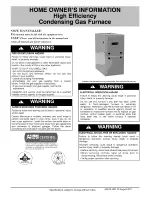
NOTE:
Clocking gas input rate MUST always be performed with
the burner box cover INSTALLED.
c. Check that gas valve adjustment caps are in place for
proper input to be clocked.
d. Obtain average heat value (at altitude) from local gas
supplier.
NOTE:
Be sure heating value of gas used for calculations is
correct for your altitude. Consult local gas utility for altitude
adjustment of gas heating value.
e. Check and verify orifice size in furnace. NEVER AS-
SUME THE ORIFICE SIZE. ALWAYS CHECK AND
VERIFY.
f. Turn off all other gas appliances and pilots.
g. Turn setup switch SW1-2 to ON position. (See Fig. 32.)
This keeps furnace locked in low-heat operation.
h. Jumper R-to-W/W1.
i. Let furnace run for 3 minutes in low-heat operation.
j. Measure time (in sec) for gas meter to complete 1
revolution. Note reading.
k. Refer to Table 13 for cubic ft of gas per hr.
l. Multiply gas rate cu ft/hr by heating value (Btu/cu ft).
m. Turn setup switch SW1-2 to OFF position and jumper R
and W/W1 and W2 thermostat connections. (See Fig.
32.) This keeps furnace locked in high-heat operation.
Repeat items i through l for high-heat operation.
EXAMPLE: (High-heat operation at 0—2000 ft altitude)
Furnace input from rating plate is 100,000 Btuh
Btu heating input = Btu/cu ft X cu ft/hr
Heating value of gas = 975 Btu/cu ft
Time for 1 revolution of 2-cu ft dial = 70 sec
Gas rate = 103 cu ft/hr (from Table 13)
Btu heating input = 103 X 975 = 100,425 Btuh
In this example, the orifice size and manifold pressure
adjustment is within
±
2 percent of the furnace input rate.
NOTE:
Measured gas inputs (high heat and low heat) must be
within
±
2 percent of that stated on furnace rating plate when
installed at sea level or derated per that stated above when installed
at higher altitudes.
n. Remove jumper across R, W/W1, and W2 thermostat
connections to terminate call for heat.
B.
Set Temperature Rise
CAUTION:
UNIT DAMAGE HAZARD
Failure to follow this caution may result in overheating
the heat exchangers or condensing flue gases in heat
exchanger areas not designed for condensate.
Temperature rise must be within limits specified on unit
rating plate. Operation is within a few degrees of mid-
point of rise range when setup switch SW1-4 is OFF.
Furnace must operate within ranges of temperature rise specified
on the furnace rating plate. Determine air temperature rise as
follows:
1. Place thermometers in return and supply ducts as near
furnace as possible. Be sure thermometers do not see heat
exchanger so that radiant heat does not affect readings. This
practice is particularly important with straight-run ducts.
2. When thermometer readings stabilize, subtract return-air
temperature from supply-air temperature to determine air
temperature rise.
NOTE:
Temperature rise can be determined for low-heat opera-
tion by placing setup switch SW1-2 on furnace control in ON
position. For high-heat operation, place setup switch SW1-2 in
OFF position and jumper R-W2 on furnace control. DO NOT
forget to return setup switch to OFF position and remove R-W2
jumper upon completion of testing. (See Fig. 32 for switch and
terminal location.)
3. This furnace is capable of automatically providing proper
airflow to maintain the temperature rise within the range
specified on furnace rating plate. If temperature rise is
outside this range, proceed as follows:
a. Check gas input for low- and high-heat operation.
TABLE 12—ALTITUDE DERATE MULTIPLIER FOR U.S.A.
ALTITUDE
(FT)
% OF
DERATE
DERATE MULTIPLIER
FACTOR
0—2000
0
1.00
2001—3000
4—6
0.95
3001—4000
6—8
0.93
4001—5000
8—10
0.91
5001—6000
10—12
0.89
6001—7000
12—14
0.87
7001—8000
14—16
0.85
8001—9000
16—18
0.83
9001—10,000
18—20
0.81
* Derate multiplier factors are based on midpoint altitudes for altitude ranges.
TABLE 13—GAS RATE CU FT/HR
SECONDS
FOR 1
REVOLUTION
SIZE OF TEST DIAL
SECONDS
FOR 1
REVOLUTION
SIZE OF TEST DIAL
1
cu ft
2
cu ft
5
cu ft
1
cu ft
2
cu ft
5
cu ft
10
11
12
13
14
360
327
300
277
257
720
655
600
555
514
1800
1636
1500
1385
1286
50
51
52
53
54
72
71
69
68
67
144
141
138
136
133
360
355
346
340
333
15
16
17
18
19
240
225
212
200
189
480
450
424
400
379
1200
1125
1059
1000
947
55
56
57
58
59
65
64
63
62
61
131
129
126
124
122
327
321
316
310
305
20
21
22
23
24
180
171
164
157
150
360
343
327
313
300
900
857
818
783
750
60
62
64
66
68
60
58
56
54
53
120
116
112
109
106
300
290
281
273
265
25
26
27
28
29
144
138
133
129
124
288
277
267
257
248
720
692
667
643
621
70
72
74
76
78
51
50
48
47
46
103
100
97
95
92
257
250
243
237
231
30
31
32
33
34
120
116
113
109
106
240
232
225
218
212
600
581
563
545
529
80
82
84
86
88
45
44
43
42
41
90
88
86
84
82
225
220
214
209
205
35
36
37
38
39
103
100
97
95
92
206
200
195
189
185
514
500
486
474
462
90
92
94
96
98
40
39
38
38
37
80
78
76
75
74
200
196
192
188
184
40
41
42
43
44
90
88
86
84
82
180
176
172
167
164
450
439
429
419
409
100
102
104
106
108
36
35
35
34
33
72
71
69
68
67
180
178
173
170
167
45
46
47
48
49
80
78
76
75
73
160
157
153
150
147
400
391
383
375
367
110
112
116
120
33
32
31
30
65
64
62
60
164
161
155
150
—48—
Summary of Contents for CONDENSING GAS FURNACE 355MAV
Page 51: ... 51 ...





























